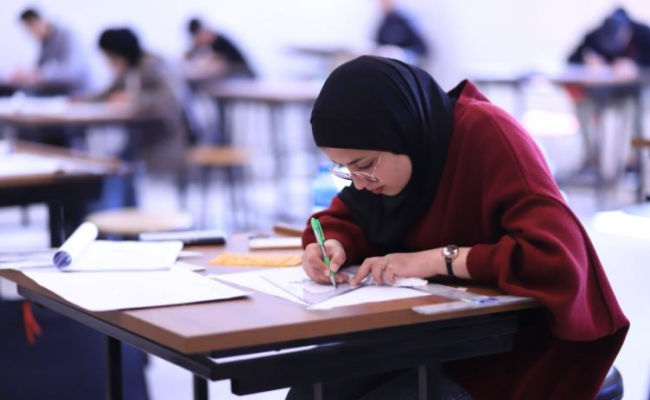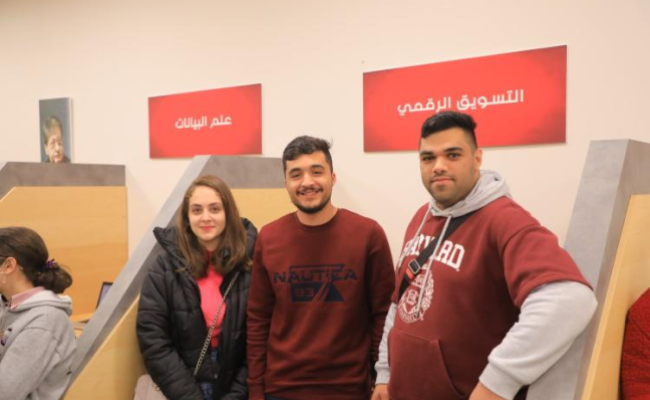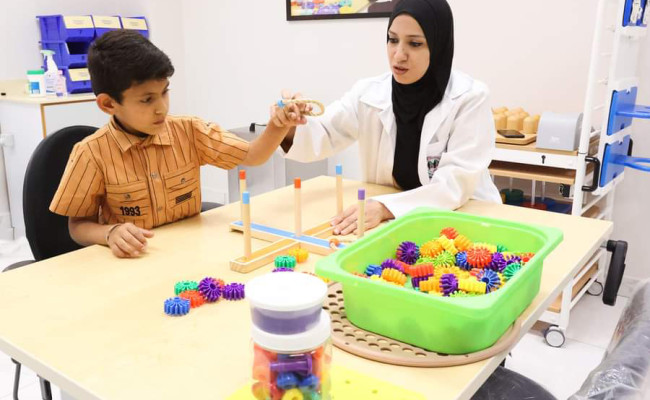Total Credit Hours Required to Finish the Degree ( 48 Credit Hours ) as Follows
Faculty Requirements
Students must pass ( 3 ) credit hours from any of the following courses
|
Course Number |
Course Name |
Weekly Hours |
Cr. Hrs. |
Prerequisite |
||
|---|---|---|---|---|---|---|
|
Theoretical |
Practical |
|||||
| 080216310 | DENTAL IMPLANTOLOGY | This course consists of theoretical and practical part. The theoretical part will consist of advanced and successful options in treating patients by dental implants supported partial fixed prostheses and implant-retained complete prostheses, in addition to patients with single missing tooth providing that there are no anatomical or psychological contra-indications. It also discusses all the basic principles of surgical and prosthetic aspects of implants, and complications. | 1 | - | 1 |
- |
| 080216320 | CLINICAL PHARMACOLOGY | This course aims to describe the clinical application of drugs including patient treatment, studies of drug application and the steps of drug development and the rules and ethics of using the dentition in experiments as declared by different committees specialized in clinical pharmacological researches as Helsinky agreement and FDA instructions. | 1 | - | 1 |
- |
| 080216330 | ORAL PHYSIOLOGY | 1 | - | 1 |
- |
|
| 080216340 | PSYCHOLOGY & BEHAVIORAL SCIENCES | A theoretical course that aims : to provide knowledge about the psychological development of humans. To cover the providing of dental treatment to patients with some of the more common clinical and sub-clinical mental disorders whether it’s a private clinic patient or a special need patient, mainly focusing on dental anxiety, panic disorders, and depression. to reviewf the more common psychotropic drugs and their possible interactions with drugs prescribed or administrated by dentists. | 1 | - | 1 |
- |
| 080216350 | ORAL PATHOLOGY | A theoretical course that provides the students with the Knowledge of the most common oral pathologic conditions and their impact on the orthodontic treatment including: (Oral cancer and pre-cancer, oral manifestations in immunocompromised patients, oral manifestations of diseases, oral ulceration, oral candidiasis, Periodontal manifestations of systemic diseases, salivary gland diseases, facial trauma, head and neck tumors). | 1 | - | 1 |
- |
| 170112160 | BASIC LIFE SUPPORT (BLS) | The Basic Life Support (BLS) course aims to provide the nursing student and healthcare professionals with exceptional emergency care skills of basic recognition to life-threatening emergencies, provide CPR, and the use an Automated External Defibrillator (AED), and relieve choking in a safe, timely and effective manner. | 1 | 0 |
- |
|
Specialization Requirements
Students must pass all of the following courses
|
Course Number |
Course Name |
Weekly Hours |
Cr. Hrs. |
Prerequisite |
||
|---|---|---|---|---|---|---|
|
Theoretical |
Practical |
|||||
| 080216010 | ORTHODONTICS I | • Theory: 1. Aetiology, diagnosis and treatment of all Classes of malocclusions, including cephalometric and other radiographic analyses. 2. Methods of growth prediction. 3. An introduction to the different types of fixed appliances used in orthodontic treatment. 4. Principle of orthodontic biomechanics. 5. Clinical examination of patients. 6. Aetiology and principles of orthodontic retention and relapse. | 1 | 3 | 2 |
- |
| 080216020 | ORTHODONTICS II | • Theory: 1. Building on the knowledge gained in Orthodontics I students will further investigate the etiology, diagnosis and treatment planning of all Classes of malocclusion. 2. An introduction to the use of cone bean computer tomography in orthodontic diagnosis and treatment planning. 3. Advanced principle of orthodontic biomechanics including the effects of force application to teeth at a cellular level. 4. Detailed clinical examination of patients including soft tissue analyses. 5. Principles of diagnosis and treatment of patients with severe malocclusions requiring combined orthodontic / orthognathic treatment. 6. Principles of use of temporary anchorage devices (TAD’s) in orthodontics. | 1 | 3 | 2 |
- |
| 080216030 | ORTHODONTICS III | 1 | - | 3 |
- |
|
| 080216040 | ORTHODONTICS IV | • Theory: 1. Building on the knowledge gained in Orthodontics II students will be provided with an advanced understanding of the etiology, diagnosis and treatment planning of all Classes of malocclusion 2. Principles of orthodontic treatment aesthetic orthodontic appliances including aesthetic labial brackets, lingual orthodontic and clear orthodontic aligners with an emphasis on identifying the advantages and limitations of these appliances. 3. Principles of diagnosis and treatment of patients with craniofacial anomalies including cleft lip and / or palate requiring multidisciplinary treatment. | 1 | - | 3 |
- |
| 080216110 | ORTHODONTIC PRACTICAL I | 1. Laboratory training :To improve the manual dexterity at wire bending and apply of the principle of orthodontic biomechanics. i. Pouring and trimming of orthodontic study models. ii. Construction of removable orthodontic appliances iii. Construction of nance appliance, transpalatal arch and lingual arch. iv. Construction of 1st, 2nd and 3rd order bends in round and rectangular archwires. v. Fixed orthodontic appliance typodont course. 2. Clinical training: i. Examination, diagnosis and treatment planning of new patients. ii. Taking full records for orthodontic patients including study models, radiographs and photographs. | - | 3 |
- |
|
| 080216120 | ORTHODONTIC PRACTICAL II | • Clinical training: 1. Examination, diagnosis and treatment planning of new patients 2. Principles of bracket placement according to different fixed orthodontic appliance techniques (MBT, Straight-Wire, etc.). 3. Treatment of patients with a wide range of malocclusion with an emphasis on the initial stages of treatment placing special emphasis on anchorage control. 4. Application of the principles of diagnosis and treatment of patients with severe malocclusions requiring combined orthodontic / orthognathic treatment (Orthognathic clinics). 5. How to follow up orthodontic treatment and measure progress. | - | 3 |
- |
|
| 080216130 | ORTHODONTIC PRACTICAL III | • Clinical training: 1. Summer course to allow follow up of orthodontic patients under treatment. 2. Examination, diagnosis and treatment planning of new patients 3. Emphasis will be places on different methods of overbite and overjet reduction including inter and intra-arch mechanics. | - | 3 |
- |
|
| 080216140 | ORTHODONTIC PRACTICAL IV | • Clinical training: 1. Examination, diagnosis and treatment planning of new patients 2. Treatment of patients with a wide range of malocclusion with an emphasis on achieving a Class I canine relationship, a normal overjet and overbite and correction of any centerline discrepancies. 3. Application of the principles of diagnosis and treatment of patients with severe malocclusions requiring combined orthodontic / orthognathic treatment (Orthognathic clinics). 4. Application of the principles of diagnosis and treatment of patients with craniofacial anomalies including cleft lip and / or palate requiring multidisciplinary treatment (Craniofacial clinics). 5. Follow up orthodontic treatment and progress measurement. | - | 3 |
- |
|
| 080216150 | ORTHODONTIC PRACTICAL V | A practical course in which the students learn how to Examine, diagnose and put a treatment plan for new patients and treatment of ongoing patients with a wide range of malocclusions with an emphasis on achieving a Class I canine relationship, a normal overjet and overbite and correction of any centerline discrepancies. In this course there is an emphasis on Application of the principles of diagnosis and treatment of patients with severe malocclusions requiring combined orthodontic / orthognathic treatment (Orthognathic clinics). Additionally there will be an Application of the principles of diagnosis and treatment of patients with craniofacial anomalies including cleft lip and / or palate requiring multidisciplinary treatment (Craniofacial clinics). | - | 3 |
- |
|
| 080216160 | ORTHODONTIC PRACTICAL VI | - | 3 |
- |
||
| 080216170 | ORTHODONTIC PRACTICAL VII | - | 2 |
- |
||
| 080216180 | ORTHODONTIC PRACTICAL VIII | - | 2 |
- |
||
| 080216190 | ORTHODONTIC PRACTICAL IX | - | 2 |
- |
||
| 080216200 | BIOMATERIALS | This course aims to improve knowledge in new materials used in clinical dentistry, their manipulation and uses in fixed and removable orthodontic appliances, maxillofacial prostheses and dental implants. In addition, laboratory studies on physical and chemical properties for these materials and their biocompatibility and effects on biological systems will be provided. | 1 | - | 1 |
- |
| 080216210 | OCCLUSION AND TREATMENT OF TMJ DISORDERS | This course describes the normal occlusion for permanent dentition, congenital anomalies, and evaluation of normal occlusion. In addition to theories of reconstruction of occlusion, types of articulators, reconstruction of occlusion using provisional restoration clinically as a temporary solution till the final reconstruction is made by permanent fixed prostheses. It also deals with problems of malocclusion and their relation with TMJ, especially with mobile teeth, fillings, crowns, periodontal problems. | 1 | - | 1 |
- |
| 080216220 | ORTHODONTICS AND RESTORATIVE/ PERIODONTAL INTERFACE | This course provides an understanding of the etiology and development of periodontal diseases, diagnosis, methods of treatment, and the periodontal considerations in Orthodontics, biological concepts and role of the periodontal tissues in the maintaining the stability of the occlusion. In addition to exposing the students to the adjuvant periodontal procedures to stabilize the corrected orthodontic tooth movements. | 1 | - | 1 |
- |
| 080216230 | SURGICAL ORTHODONTICS & RADIOLOGY | Course aimed to help students become competent to recognize and identify abnormalities and pathological conditions that can be diagnosed on radiographs, apply the As Low As Reasonably Achievable principles, | 1 | - | 1 |
- |
| 080216240 | ORTHODONTICS AND PEDIATRIC DENTISTRY INTERFACE | This provides a foundation for the student to understand the treatment needs of children who require multidisciplinary management. It also discusses the team approach to the management of the developing dentition and occlusion and applying the principles of prevention and interceptive treatment procedures. | 1 | - | 1 |
- |
| 080216250 | RESEARCH METHODOLOGY | The purpose of this course is to give a general introduction to research methods. The course comprises a detailed module in statistics. This course presents the principles of statistics as they apply to medical research, with examples chosen specifically from dental research. Parallel to this module is a concurrent broad-based lecture program that includes basic principles of research and research methodology, computer applications in word processing, graphics and system operating and lectures from each of the four research groups in the dental school. The purpose of this lecture course is to illustrate research currently in progress, emphasizing the principles and procedures entailed in the research projects. | 3 | - | 3 |
- |
| 080216300 | BIOSTATISTICS | This course focuses upon organizing and summarizing data, sampling methods and statistical distributions (binomial Poisson X2 , t and F); sampling methods and distributions, estimation and hypotheses about means, proportions and variances bases on large and small samples: analysis of variance (one way, two-way, factorial designs, Lating square), regression analysis (simple and multiple), Chi-square-tests, nonparametric methods, and correlation coefficient, environmental and biostatistical data. | 3 | - | 3 |
- |
Hidden Text






